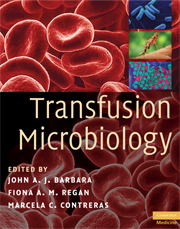Book contents
- Frontmatter
- Contents
- List of contributors
- Foreword
- Preface
- Acknowledgements
- Glossary
- Introduction: Transfusion-transmitted infections, then and now
- Section 1 Agents
- Section 2 Selection and testing
- Section 3 Surveillance, risk and regulation
- 21 Serious hazards of transfusion (SHOT); haemovigilance
- 22 Investigation of post-transfusion infection
- 23 Notification of donors with significant microbiological test results
- 24 Researching the natural history of transfusion-transmitted infections: the UK hepatitis C (HCV) national register
- 25 How to assess risk: prospective studies and calculations
- 26 Risk management
- 27 The regulatory environment in Europe
- 28 Blood safety in developing countries
- Index
- Plate section
- References
22 - Investigation of post-transfusion infection
from Section 3 - Surveillance, risk and regulation
Published online by Cambridge University Press: 12 January 2010
- Frontmatter
- Contents
- List of contributors
- Foreword
- Preface
- Acknowledgements
- Glossary
- Introduction: Transfusion-transmitted infections, then and now
- Section 1 Agents
- Section 2 Selection and testing
- Section 3 Surveillance, risk and regulation
- 21 Serious hazards of transfusion (SHOT); haemovigilance
- 22 Investigation of post-transfusion infection
- 23 Notification of donors with significant microbiological test results
- 24 Researching the natural history of transfusion-transmitted infections: the UK hepatitis C (HCV) national register
- 25 How to assess risk: prospective studies and calculations
- 26 Risk management
- 27 The regulatory environment in Europe
- 28 Blood safety in developing countries
- Index
- Plate section
- References
Summary
This chapter is primarily concerned with the investigation of reports of infection in transfusion recipients, in order to determine whether the infection was transmitted to the patient by transfusion. In addition, the question of ‘look-back’ is briefly considered. We describe our experience in the National Blood Service (NBS), England.
Introduction
The NBS provides a service to England and North Wales from 12 centres sited throughout the country. All staff involved in the investigation of post-transfusion infection work to national policies and procedures which have been developed as a result of experience over the last 25 years.
The NBS is part of the National Health Service and therefore has strong links and good communication with hospital clinicians, hospital transfusion laboratories and general practitioners. Since the late 1990s there have been NBS hospital liaison staff whose role is to work closely with the hospital transfusion laboratories and hospital transfusion committees. This initiative has strengthened the flow of information and communication between the NBS and the hospitals it serves.
Reports of possible infection associated with blood transfusion may arise from a number of sources, but within the NBS all reports reach one central office which has close links with the Serious Hazards of Transfusion scheme (SHOT). (Please refer to Chapter 21) Although the investigation of possible transfusion-transmitted infection involves liaison locally with hospitals and donors, the process is managed centrally within the transfusion microbiology clinical function of the NBS and each case is reviewed at the close of the investigation.
- Type
- Chapter
- Information
- Transfusion Microbiology , pp. 311 - 316Publisher: Cambridge University PressPrint publication year: 2008



